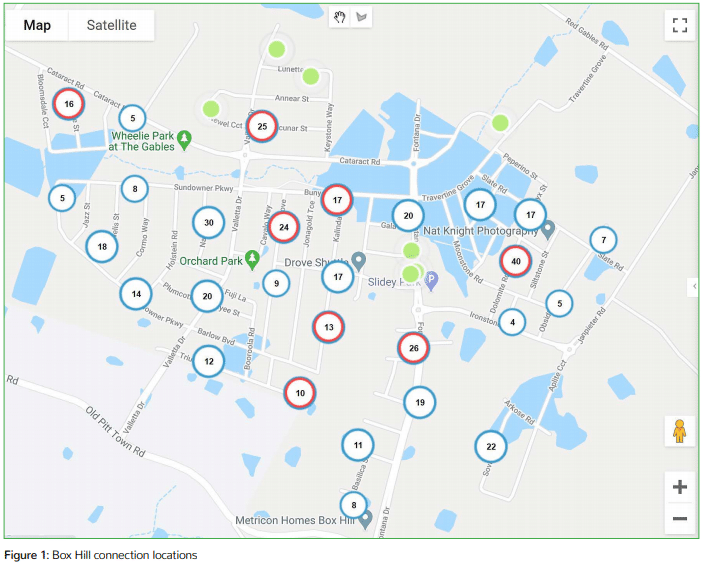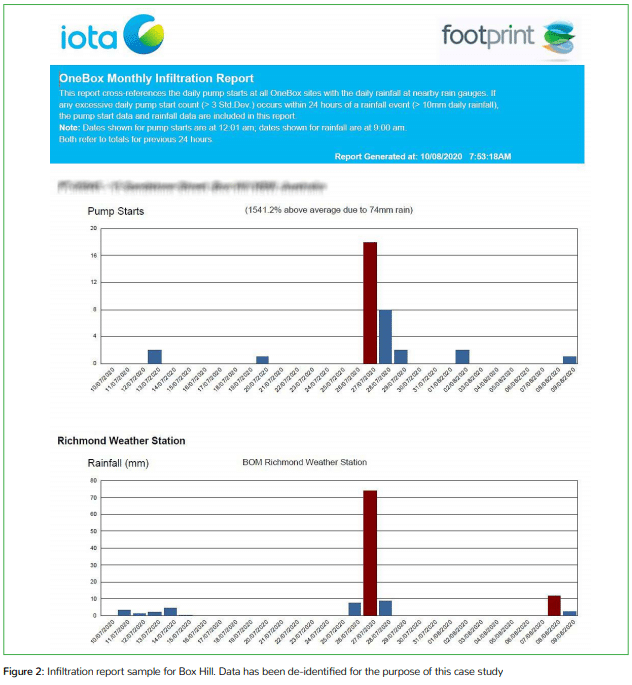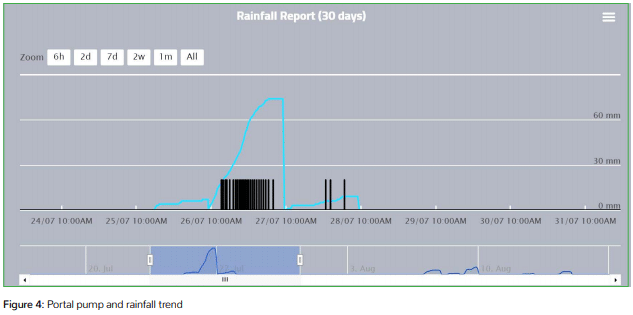Inflow & Infiltration (I&I) is a common problem within all sewer networks. Whilst pressure sewer enables rejection of I&I in the network, on-lot plumbing is susceptible to I&I particularly where high water table or local flooding is possible. The common causes of I&I are identified as follows:
- Direct stormwater pipe connection particularly where pressure sewer is replacing failed septic tanks or from secondary dwellings.
- Overflow of tank vent or ORG on property due to local ponding.
- Leaking into lateral pipework or connection joints to tanks in high water table scenario.
These various I&I sources can be identified through monitoring and offers the opportunity to proactively address I&I.
Altogether, an innovative and sustainably driven multiutility, has collaborated with Iota to utilise smart pressure sewer monitoring and control with OneBox® to actively address I&I in its pressure sewer networks.
The impact of I&I in a pressure sewer network can be significant with the ability of just a small handful of properties contributing significant flow to downstream assets. This can be seen in the context of average household pumping duration of just 12.5 minutes per day and the impact of continual pumping associated with significant I&I.
“Having visibility of the network through the Iota Portal during a wet weather event is absolutely critical in preventing spills and damage to pumps.”
DARREN WHARTON
EXECUTIVE MANAGER, SUSTAINABLE UTILITY SERVICES
The Altogether Experience of Inflow and Infiltration
The new residential development area of the Gables, Box Hill in Western Sydney is a good case study for I&I with increased surface and ground water flow creating operational risk of I&I during significant
wet weather events.
Figure 1 below from the OneBox® portal shows a heat map of connection locations with the farm dams infilled for development still showing on the Google maps background. The numbered circles show the number of connections in that location with zooming in on scale to show individual connections.

During recent wet weather events the Altogether technicians were able to accurately pinpoint the connections with I&I issues through a monthly Infiltration Report provided by Iota which flags infiltration sites after a rain event by comparing the pump runtime standard deviation and local rainfall data from the Bureau of Meteorology. Figure 2 below shows a typical infiltration report with rainfall event of 27/7/2020 coinciding with increase in pump runs. The colour coding of the bar graph indicates rainfall events greater than 10mm/day and pump runs with standard deviation difference. In this case on the 27/07 the rain event record shows 74mm in 24 hours and the pump run shows 18 pump runs where average prior less than 1 per day.

A weekly pump runtime report which summaries pump runtime per day for individual sites is automatically generated and issued to designated Altogether technicians. This report has facilitated an accurate quantification assessment of I&I by Altogether technicians to prioritise target investment in I&I removal. The runtime report in .csv format facilitates listing by highest pump runtimes to quickly focus on priority sites in a large network. Figure 3 below shows the report format with pump starts per day and total runtime in seconds per day for each connection site.

The Iota Portal
Visualisation of I&I sites on the Iota OneBox® Portal also confirms sites with I&I issues for targeted intervention, allows tagging of properties with suspected I&I and facilitates confirmation of successful intervention in future wet weather events. Figure 4 below shows the rainfall trend from the Richmond Weather Station in blue with trend line reverting to zero after 24 hours. Major rainfall above 70mm recorded on the 27/07. The pump start and stop is recorded as the black line step up. Continual start stop pumping observed during rain event.

Outcome
Visiting these identified target sites during wet weather has facilitated Altogether technicians in preventing damage to those sites with dry well mounted pumps and consequently reduced potential spill risk. Presence on critical sites has allowed Altogether technicians to observe the source I&I which included the use of a Go-pro camera within the tank for the observation of infiltration through leaking lateral pipe connections.
A request by Altogether personnel for more granular hourly pump runtime on specific wet days has facilitated a better diagnostic of I&I, distinguishing inflow continuing after rainfall as being indicative of water table ingress and inflow peaks aligning more closely with rainfall indicating direct stormwater inflow.
The opportunity provided by the near real time monitoring with the Onebox® and the Altogether systematic approach to data analysis and targeted interventions will continue to drive down I&I to negligible levels.
The targeted removal of I&I has had immediate impact on network peak flows. The associated reduction in peak flows during significant wet weather events will be further enhanced with the ability to remotely inhibit flows using the OneBox® from part or all of the network with a fully controlled recovery following prolonged inhibit. This approach will maintain a controlled peak flow for the Box Hill pressure sewer network regardless of weather conditions into the future.
“Iota has helped Altogether to realise our vision of a smart pressure system to provide the best possible customer experience.”
DARREN WHARTON
EXECUTIVE MANAGER SUSTAINABLE UTILITY SERVICES



